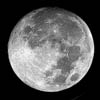Courtesy of EarthSky
A Clear Voice for Science
Visit EarthSky at
www.EarthSky.org

 The April 2011 full moon will be out all night on April 17, lighting up the nighttime from dusk until dawn.
The April 2011 full moon will be out all night on April 17, lighting up the nighttime from dusk until dawn.
Watch for the moon low in the east at dusk – at its highest point in the sky around midnight – and low in the west before the sun comes up tomorrow.
Why isn’t there an eclipse every full moon?
For the northern hemisphere, this is the first full moon of springtime. We in this hemisphere call it the Pink Moon, to celebrate the return of certain wild flowers. Other names are Egg Moon, Sprouting Grass Moon, or Easter Moon. In most years, the Christian celebration of Easter falls on the first Sunday after the first full moon of the northern hemisphere spring. So tonight’s Easter Moon heralds the coming of Easter Sunday on April 24, 2011.
Looking for a sky almanac? EarthSky recommends . . .
In the southern hemisphere, this is the first full moon of autumn. It’s the southern hemisphere’s Hunter’s Moon – which follows the Harvest Moon, the closest full moon to the autumn equinox – a March event for the southern hemisphere. The Harvest Moon and Hunter’s Moon are characterized by their rising times. They rise soon after sunset for several nights in a row. Watch for them if you are in that part of the world.
Tonight’s full moon shines near the star Spica, the brightest star in the constellation Virgo. The other bright light is no star at all but the planet Saturn. The first full moon to follow the March equinox faithfully shines in front of Virgo, the harvest goddess, to signal the change of seasons.
Full moon: April 17, 2011, at 9:44 p.m. Central Daylight Time (By Universal Time: April 18, 2011, at 2:44)
Astronomy Picture of the Day from NASA/JPL
U.S. Naval Observator Astronomical Information center
The York County Astronomical Society